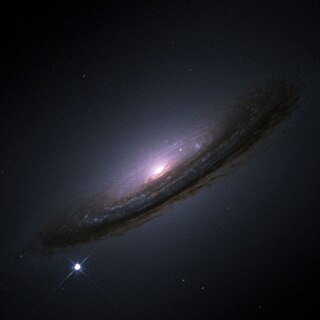The Chandrasekhar limit is the maximum mass of a stable white dwarf star. The currently accepted value of the Chandrasekhar limit is about 1.4 M☉ (2.765×1030 kg).

A nova is a transient astronomical event that causes the sudden appearance of a bright, apparently "new" star, that slowly fades over several weeks or many months. Causes of the dramatic appearance of a nova vary, depending on the circumstances of the two progenitor stars. All observed novae involve white dwarfs in close binary systems. The main sub-classes of novae are classical novae, recurrent novae (RNe), and dwarf novae. They are all considered to be cataclysmic variable stars.

A star is an astronomical object comprising a luminous spheroid of plasma held together by its gravity. The nearest star to Earth is the Sun. Many other stars are visible to the naked eye at night, but their immense distances from Earth make them appear as fixed points of light. The most prominent stars have been categorised into constellations and asterisms, and many of the brightest stars have proper names. Astronomers have assembled star catalogues that identify the known stars and provide standardized stellar designations. The observable universe contains an estimated 1022 to 1024 stars. Still, most are invisible to the naked eye from Earth, including all individual stars outside our galaxy, the Milky Way.

A supernova is a powerful and luminous stellar explosion. This transient astronomical event occurs during the last evolutionary stages of a massive star or when a white dwarf is triggered into runaway nuclear fusion. The original object, called the progenitor, either collapses to a neutron star or black hole, or is completely destroyed. The peak optical luminosity of a supernova can be comparable to that of an entire galaxy before fading over several weeks or months.

Stellar evolution is the process by which a star changes over the course of time. Depending on the mass of the star, its lifetime can range from a few million years for the most massive to trillions of years for the least massive, which is considerably longer than the age of the universe. The table shows the lifetimes of stars as a function of their masses. All stars are formed from collapsing clouds of gas and dust, often called nebulae or molecular clouds. Over the course of millions of years, these protostars settle down into a state of equilibrium, becoming what is known as a main-sequence star.

A white dwarf is a stellar core remnant composed mostly of electron-degenerate matter. A white dwarf is very dense: its mass is comparable to that of the Sun, while its volume is comparable to that of Earth. A white dwarf's faint luminosity comes from the emission of residual thermal energy; no fusion takes place in a white dwarf. The nearest known white dwarf is Sirius B, at 8.6 light years, the smaller component of the Sirius binary star. There are currently thought to be eight white dwarfs among the hundred star systems nearest the Sun. The unusual faintness of white dwarfs was first recognized in 1910. The name white dwarf was coined by Willem Luyten in 1922.
Timeline of neutron stars, pulsars, supernovae, and white dwarfs
In astronomy, the term compact star refers collectively to white dwarfs, neutron stars, and black holes. It would grow to include exotic stars if such hypothetical, dense bodies are confirmed to exist. All compact objects have a high mass relative to their radius, giving them a very high density, compared to ordinary atomic matter.

The cosmic distance ladder is the succession of methods by which astronomers determine the distances to celestial objects. A real direct distance measurement of an astronomical object is possible only for those objects that are "close enough" to Earth. The techniques for determining distances to more distant objects are all based on various measured correlations between methods that work at close distances and methods that work at larger distances. Several methods rely on a standard candle, which is an astronomical object that has a known luminosity.

Gravitational collapse is the contraction of an astronomical object due to the influence of its own gravity, which tends to draw matter inward toward the centre of gravity. Gravitational collapse is a fundamental mechanism for structure formation in the universe. Over time an initial, relatively smooth distribution of matter will collapse to form pockets of higher density, typically creating a hierarchy of condensed structures such as clusters of galaxies, stellar groups, stars and planets.

NGC 5189 is a planetary nebula in the constellation Musca. It was discovered by James Dunlop on 1 July 1826, who catalogued it as Δ252. For many years, well into the 1960s, it was thought to be a bright emission nebula. It was Karl Gordon Henize in 1967 who first described NGC 5189 as quasi-planetary based on its spectral emissions.

A nova remnant is made up of the material either left behind by a sudden explosive fusion eruption by classical novae, or from multiple ejections by recurrent novae. Over their short lifetimes, nova shells show expansion velocities of around 1000 km/s, whose faint nebulosities are usually illuminated by their progenitor stars via light echos as observed with the spherical shell of Nova Persei 1901 or the energies remaining in the expanding bubbles like T Pyxidis.

The following outline is provided as an overview of and topical guide to astronomy:

A Type Ia supernova is a type of supernova that occurs in binary systems in which one of the stars is a white dwarf. The other star can be anything from a giant star to an even smaller white dwarf.

IK Pegasi is a binary star system in the constellation Pegasus. It is just luminous enough to be seen with the unaided eye, at a distance of about 154 light years from the Solar System.

In astronomy, a common envelope (CE) is gas that contains a binary star system. The gas does not rotate at the same rate as the embedded binary system. A system with such a configuration is said to be in a common envelope phase or undergoing common envelope evolution.

A stellar collision is the coming together of two stars caused by stellar dynamics within a star cluster, or by the orbital decay of a binary star due to stellar mass loss or gravitational radiation, or by other mechanisms not yet well understood.
p-nuclei are certain proton-rich, naturally occurring isotopes of some elements between selenium and mercury inclusive which cannot be produced in either the s- or the r-process.

KPD 1930+2752 is a binary star system including a subdwarf B star and a probable white dwarf with relatively high mass. Due to the nature of this astronomical system, it seems like a likely candidate for a potential type Ia supernova, a type of supernova which occurs when a white dwarf star takes on enough matter to approach the Chandrasekhar limit, the point at which electron degeneracy pressure would not be enough to support its mass. However, carbon fusion would occur before this limit was reached, releasing enough energy to overcome the force of gravity holding the star together and resulting in a supernova.
iPTF14atg is a type-Ia supernova discovered on 3 May 2015. The supernova is located in galaxy IC 831, some 300 Mly (92 Mpc) distant. The supernova is thought to have ignited on May 2 or 3. The supernova's shockwave slammed into a companion star, shocking it into producing an ultraviolet pulse. The companion star that was hit is suspected to be a red giant star. This detection of the UV signal represents the first time the collision event of a supernova shockwave upon a companion star has been detected. The supernova was discovered by the Intermediate Palomar Transient Factory (iPTF), a successor to the earlier Palomar Transient Factory, and based at the Palomar Observatory in California. The data was processed by collaborators in Europe, that lead to the supernova discovery.
![]() 19h 13m 05.239s, +15° 46′ 39.80″
19h 13m 05.239s, +15° 46′ 39.80″ 














